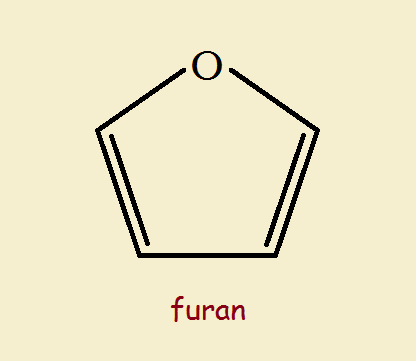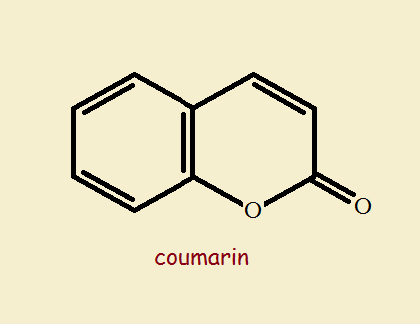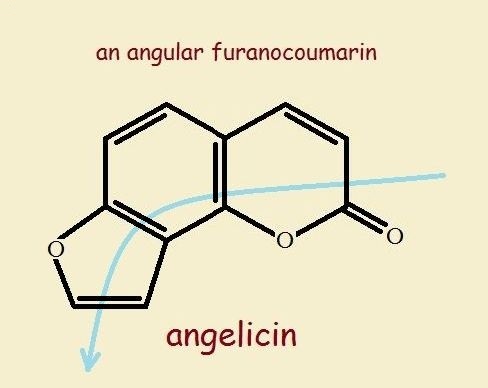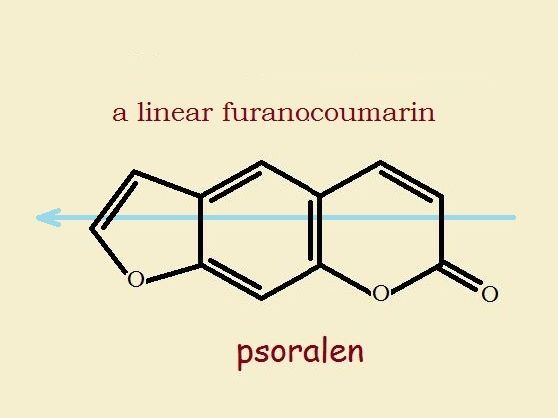
The Giant Hogweed is a hot topic in the United Kingdom, and now also in the United States. Have you personally “experienced” the Giant Hogweed, Heracleum mantegazzianum?
We’re not speaking of Heracleum sphondylium, the Common Hogweed, no.
Giant Hogweed has a horrific reputation, and is widely considered a noxious weed. Its reputation has taken it from the hospital and the laboratory to detective TV. For instance, Giant Hogweed is the weapon of choice in the Rosemary & Thyme pilot episode entitled, “And No Birds Sing.”
Giant Hogweed Toxins
The chemicals in Giant Hogweed that provide its sordid reputation are furanocoumarins – or (for short) furocoumarins. This name is derived from the characteristic two ring portions they share in common – from furan and coumarin.

These two ring structures can be attached to each other in more than one way. There are linear (straight) and angular (bent) furanocoumarins. In particular, it is the linear furanocoumarins that present the problem. The best-known linear furanocoumarin is psoralen; the best-known angular furanocoumarin is angelicin. Angelicin is sometimes called isopsoralen. The iso- part of the name refers to its being a nearly identical isomer of psoralen.
The linear furanocoumarins constitute the prime culprit, yet this culprit has an accomplice – sunlight! Yes, these culprit compounds are phototoxins, nearly harmless compounds made dangerous by light.

Hogweed Chemistry
Psoralen and its derivatives are high ultraviolet light-absorbers. With special medical supervision they can be used to treat specific skin (and other) conditions. Random exposure, though, usually produces tragic results, even fatality.
View DNA as a kind of circular staircase. The staircase banisters are made of sugar bonded to phosphate. Steps? There are two kinds. Adenine joined by thymine is one kind of step. Guanine joined by cytosine is the other kind.
Epidermal (skin) cells readily absorb psoralen. Getting absorbed by the skin is a task in itself, as most substances are blocked by the skin’s lipid-rich outer layer, the stratum corneum. Once absorbed, linear furanocoumarins, such as psoralen, insert themselves between adjacent DNA base pairs, especially those of thymine. What does this mean?
If ultraviolet light is absorbed by the cells with the psoralen inserts (AKA intercalations), these inserts undergo reaction, producing cross links called adducts that join two different DNA molecules together.
Crudely, this may be compared to what happens when a raw egg is boiled. The protein in the egg completely changes. In the case of our DNA, it can no longer function or change back into what it was. The cells containing it are destroyed. This is obvious when we see the swelling, discoloration, and severe blistering when exposure to Giant Hogweed is not properly and immediately treated.

On the Flip Side
“Every cloud must have a silver lining…”
This is true of psoralen derivatives such as those found in the Giant Hogweed, even if that silver lining seems pretty thin. Most powerful medications are, after all, simply poisons that are used very judiciously.

Psoralen plus UVA light (PUVA) is used to treat psoriasis, vitiligo, and other skin conditions. UVA penetrates deeper than UVB light, and previously applied psoralen derivatives interact with it to lessen the effects of psoriasis. Ongoing research will doubtless increase the value of this “silver lining”.
Another beneficial use of a number of furanocoumarins is the “grapefruit juice effect.”
The drug rapamycin is an auto-immune suppressant. Such medications, as might be imagined, are best used at low dosages. Now rapamycin is poorly absorbed, which inhibits using a low dosage level. But grapefruit juice is rich in furanocoumarins. This greatly enhances absorption of the expensive drug – and also lowers its rate of breakdown by the body. This makes it possible to lower dosages of rapamycin by a factor of four!
Finally, psoralen and other furanocoumarins are being developed and utilized in the treatment of cancer, certainly a large gray cloud suspended over the world of mankind.
Note: You might also enjoy Pituitary Gigantism and Acromegaly
References:
- FANDOM: Rosemary & Thyme Wikia
- National Institutes of Health. LiverTox – Psoralen
- Berkeley University. Sharp Kink of DNA at Psoralen-cross-link Site Deduced from Crystal Structure of Psoralen-Thymine Monoadduct. (1983)
- Mayo Clinic. Psoriasis: Treatment
- World Journal of Clinical Oncology Baishideng Publishing Group. Effects of psoralens as anti-tumoral agents in breast cancer cells. (2014)
← Back to Food and Health
← Home
